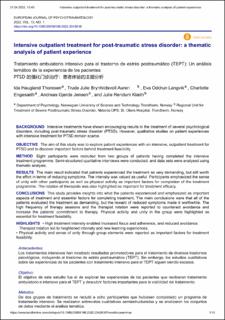| dc.contributor.author | Auren, Trude Julie Brynhildsvoll | |
| dc.contributor.author | Langvik, Eva | |
| dc.contributor.author | Engesæth, Charlotte | |
| dc.contributor.author | Jensen, Andreas Gjerde | |
| dc.contributor.author | Klæth, Julie Rendum | |
| dc.contributor.author | Thoresen, Ida Haugland | |
| dc.date.accessioned | 2022-05-10T12:32:25Z | |
| dc.date.available | 2022-05-10T12:32:25Z | |
| dc.date.created | 2022-05-03T14:43:45Z | |
| dc.date.issued | 2022 | |
| dc.identifier.citation | European Journal of Psychotraumatology. 2022, 13 (1), . | en_US |
| dc.identifier.issn | 2000-8066 | |
| dc.identifier.uri | https://hdl.handle.net/11250/2995095 | |
| dc.description.abstract | Background
Intensive treatments have shown encouraging results in the treatment of several psychological disorders, including post-traumatic stress disorder (PTSD). However, qualitative studies on patient experiences with intensive treatment for PTSD remain scarce.
Objective
The aim of this study was to explore patient experiences with an intensive, outpatient treatment for PTSD and to discover important factors behind treatment feasibility.
Method
Eight participants were recruited from two groups of patients having completed the intensive treatment programme. Semi-structured qualitative interviews were conducted, and data sets were analysed using thematic analysis.
Results
The main result indicated that patients experienced the treatment as very demanding, but still worth the effort in terms of reducing symptoms. The intensity was valued as useful. Participants emphasized the sense of unity with other participants as well as physical activity as important factors for completion of the treatment programme. The rotation of therapists was also highlighted as important for treatment efficacy.
Conclusions
This study provides insights into what the patients experienced and emphasized as important aspects of treatment and essential factors for completing treatment. The main conclusions were that all of the patients evaluated the treatment as demanding, but the reward of reduced symptoms made it worthwhile. The high frequency of therapy sessions and the therapist rotation were reported to counteract avoidance and increase the patients’ commitment to therapy. Physical activity and unity in the group were highlighted as essential for treatment feasibility. | en_US |
| dc.language.iso | eng | en_US |
| dc.publisher | Taylor & Francis Open Access | en_US |
| dc.rights | Navngivelse-Ikkekommersiell 4.0 Internasjonal | * |
| dc.rights.uri | http://creativecommons.org/licenses/by-nc/4.0/deed.no | * |
| dc.title | Intensive outpatient treatment for post-traumatic stress disorder: a thematic analysis of patient experience | en_US |
| dc.title.alternative | Intensive outpatient treatment for post-traumatic stress disorder: a thematic analysis of patient experience | en_US |
| dc.type | Peer reviewed | en_US |
| dc.type | Journal article | en_US |
| dc.description.version | publishedVersion | en_US |
| dc.source.pagenumber | 13 | en_US |
| dc.source.volume | 13 | en_US |
| dc.source.journal | European Journal of Psychotraumatology | en_US |
| dc.source.issue | 1 | en_US |
| dc.identifier.doi | https://doi.org/10.1080/20008198.2022.2043639 | |
| dc.identifier.cristin | 2021067 | |
| cristin.ispublished | true | |
| cristin.fulltext | original | |
| cristin.qualitycode | 1 | |

